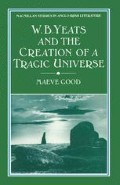Abstract
In this chapter I explore four plays: Calvary, The Resurrection, The Words upon the Window-Pane and Purgatory. These plays help to define Yeats’s Vision of Evil and its place in his tragic vision. The term ‘Vision of Evil’ implies vision, the apocalypse which I attempted to define in the last chapter, a revelation of what is ‘really and unchangeably’ (E&I, p. 116). The question of evil manifests itself in two forms in Yeats’s writings. First, Yeats’s cyclical system, his rejection of the absolute of Christianity, is pessimistic. The ideal society has no place on earth, in heaven or in history. At moments, at the climax of a civilisation, a momentary harmony may be achieved, but its very achievement contains within it a downward pull. Chaos and anarchy must return. Within this framework the individual is forced to confront his own destruction, his own death. The Vision of Evil is at its simplest the revelation of this inevitability, darkness, frustration and defeat.
Access this chapter
Tax calculation will be finalised at checkout
Purchases are for personal use only
Preview
Unable to display preview. Download preview PDF.
Notes
Martin Buber, Eclipse of God: Studies in the Relation between Religion and Philosophy (New York: Harper, 1957) p. 87; quoted in Whitaker, Swan and Shadow, p. 50.
A. C. Bradley, Oxford Lectures on Poetry (London: Macmillan, 1959) p. 71.
T. R. Henn, The Harvest of Tragedy (London: Methuen, 1966) pp. 65–71.
James Thompson, ‘City of Dreadul Night’, Poems of Faith and Doubt: The Victorian Age, ed. R. L. Brett (London: Edward Arnold, 1965) p. 170; quoted in Henn, The Harvest of Tragedy, p. 68.
Paul Tillich, The Shaking of the Foundations (Harmondsworth: Penguin, 1962) pp. 27–9.
Whitaker, Swan and Shadow, pp. 43–6. See also F. A. C. Wilson, Yeats’s Iconography (London: Gollancz, 1960) pp. 173–4.
Jonathan Swift, A Tale of the Tubs, with Other Early Works, 1696–707, ed. Herbert Davis (Oxford: Blackwell, 1939) p. 228.
Douglas N. Archibald, ‘Yeats’s Encounter with Jonathan Swift’, in Yeats and the Theatre, Yeats Studies no. 1, ed. Robert O’Driscoll and Lorna Reynolds (London: Macmillan, 1975) p. 198.
Donald Torchiana, in W. B. Yeats and Georgian Ireland (Evanston, Ill.: Northwestern University Press, 1966) p. 127, refers both to this letter and to a passage in Autobiographies (p. 330) where Yeats again describes ‘these holy victims’. He talks of psychical research offering evidence to support legends about saints who ‘did really cure disease by taking it upon themselves. As disease was considered the consequence of sin, to take it upon themselves was to copy Christ.’
Richard Ellmann, Yeats, The Man and the Masks (London: Oxford University Press, 1979) p. 201. (First published 1949.)
Jonathan Swift, Gulliver’s Travels (Harmondsworth: Penguin, 1979) p. 315.
F. A. Lucas, The Drama of Chekhov, Synge, Yeats and Pirandello (London: Cassell, 1963) pp. 337–9.
Peter Ure, Yeats the Playwright: A Commentary on Character and Design in the Major Plays (London: Routledge and Kegan Paul, 1963) p. 107.
F. A. C. Wilson, Yeats and Tradition (London: Gollancz, 1959) p. 163.
Denis Donoghue, ‘The Human Image in Yeats’, in Irish University Review, III, no. 8 (1966) 56.
Francis Stuart, Black List, Section H (London: Martin Brian and O’Keefe, 1975) p. 122. See also p. 44, where Stuart comments, He believed that nothing short of the near despair of being utterly cast off from society and its principles could create the inner condition conducive to the new insights that it was the task of the poet to reveal…. Yeats, for all his superb craftsmanship and intellectual passion, was not going to cause any real alteration or reorientation in inner attitudes because he had not been forced to the point of extreme loneliness. Such a reorientation of inner attitudes, such despair and loneliness is, I should argue, the hallmark of the later Yeats and reaches its climax in The Words upon the Window-Pane and Purgatory.
Copyright information
© 1987 Maeve Good
About this chapter
Cite this chapter
Good, M. (1987). Four Plays and the Problem of Evil. In: W. B. Yeats and the Creation of a Tragic Universe. Macmillan Studies in Anglo-Irish Literature. Palgrave Macmillan, London. https://doi.org/10.1007/978-1-349-08246-9_5
Download citation
DOI: https://doi.org/10.1007/978-1-349-08246-9_5
Publisher Name: Palgrave Macmillan, London
Print ISBN: 978-1-349-08248-3
Online ISBN: 978-1-349-08246-9
eBook Packages: Palgrave Literature & Performing Arts CollectionLiterature, Cultural and Media Studies (R0)

